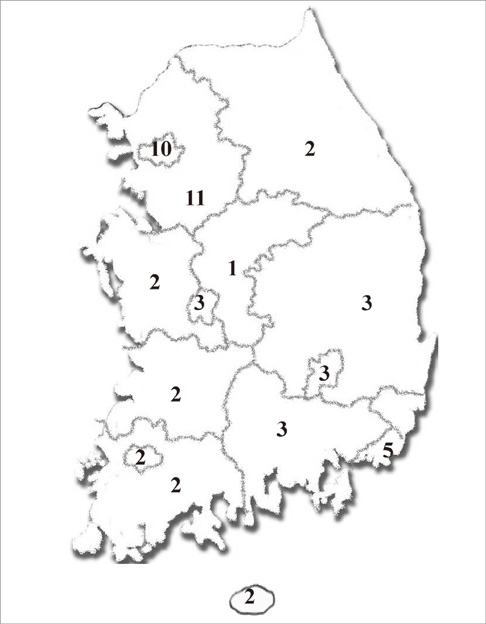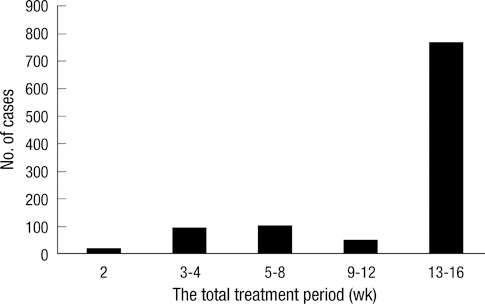J Korean Med Sci.
2011 Dec;26(12):1613-1618. 10.3346/jkms.2011.26.12.1613.
Practice Pattern of Gastroenterologists for the Management of GERD Under the Minimal Influence of the Insurance Reimbursement Guideline: A Multicenter Prospective Observational Study
- Affiliations
-
- 1Department of Gastroenterology, Ajou University School of Medicine, Suwon, Korea.
- 2Department of Internal Medicine, the Catholic University of Korea College of Medicine, Seoul, Korea.
- 3Department of Internal Medicine, Bundangjesaeng Hospital, Seongnam, Korea.
- 4Department of Internal Medicine, Sejong Hospital, Bucheon, Korea.
- 5Department of Internal Medicine, Seoul National University College of Medicine, Seoul, Korea.
- 6Department of Internal Medicine, Yonsei University College of Medicine, Seoul, Korea.
- 7Department of Internal Medicine, University of Ulsan College of Medicine, Ulsan, Korea.
- 8Department of Internal Medicine, Chung-Ang University College of Medicine, Seoul, Korea.
- 9Department of Internal Medicine, Kyungpook University College of Medicine, Daegu, Korea.
- 10Department of Internal Medicine, Pusan National University College of Medicine, Busan, Korea.
- 11Department of Internal Medicine, Korea University College of Medicine, Seoul, Korea. drchunhj@chol.com
- KMID: 1786018
- DOI: http://doi.org/10.3346/jkms.2011.26.12.1613
Abstract
- The objective of the study was to document practice pattern of gastroenterologists for the management of gastroesophageal reflux disease (GERD) under the minimal influence of the insurance reimbursement guideline. Data on management for 1,197 consecutive patients with typical GERD symptoms were prospectively collected during 16 weeks. In order to minimize the influence of reimbursement guideline on the use of proton pump inhibitors (PPIs), rabeprazole was used for the PPI treatment. A total of 861 patients (72%) underwent endoscopy before the start of treatment. PPIs were most commonly prescribed (87%). At the start of treatment, rabeprazole 20 mg daily was prescribed to 94% of the patients who received PPI treatment and 10 mg daily to the remaining 6%. At the third visits, rabeprazole 20 mg daily was prescribed to 70% of those who were followed and 10 mg daily for the remaining 30%. Continuous PPI treatment during the 16-week period was performed in 63% of the study patients. In conclusion, a full-dose PPI is preferred for the initial and maintenance treatment of GERD under the minimal influence of the insurance reimbursement guideline, which may reflect a high proportion of GERD patients requiring a long-term treatment of a full-dose PPI.
MeSH Terms
-
2-Pyridinylmethylsulfinylbenzimidazoles/therapeutic use
Adult
Aged
Aged, 80 and over
Enzyme Inhibitors
Female
Gastroenterology
Gastroesophageal Reflux/*diagnosis/*drug therapy
*Guideline Adherence
Humans
Insurance, Health, Reimbursement
Male
Middle Aged
*Physician's Practice Patterns
Proton Pump Inhibitors/therapeutic use
Republic of Korea
Treatment Outcome
Figure
Reference
-
1. Dent J, El-Serag HB, Wallander MA, Johansson S. Epidemiology of gastro-esophageal reflux disease: a systematic review. Gut. 2005. 54:710–717.2. Wong BC, Kinoshita Y. Systematic review on epidemiology of gastroesophageal reflux disease in Asia. Clin Gastroenterol Hepatol. 2006. 4:398–407.3. Yang SY, Lee OY, Bak YT, Jun DW, Lee SP, Lee SH, Park GT, Yoon BC, Choi HS, Hahm JS, Lee MH, Lee DH. Prevalence of gastroesophageal reflux disease symptoms and uninvestigated dyspepsia in Korea: a population-based study. Dig Dis Sci. 2008. 53:188–193.4. Cho YS, Choi MG, Jeong JJ, Chung WC, Lee IS, Kim SW, Han SW, Choi KY, Chung IS. Prevalence and clinical spectrum of gastroesophageal reflux: a population-based study in Asan-si, Korea. Am J Gastroenterol. 2005. 100:747–753.5. Lee SY, Lee KJ, Kim SJ, Cho SW. Prevalence and risk factors for overlaps between gastroesophageal reflux disease, dyspepsia, and irritable bowel syndrome: a population-based study. Digestion. 2009. 79:196–201.6. Vakil N, van Zanten SV, Kahrilas P, Dent J, Jones R. Global Consensus Group. The Montreal definition and classification of gastroesophageal reflux disease: a global evidence-based consensus. Am J Gastroenterol. 2006. 101:1900–1920.7. Dent J, Brun J, Fendrick AM, Fennerty MB, Janssens J, Kahrilas P, Lauritsen K, Reynolds JC, Shaw M, Talley N. An evidence-based appraisal of reflux disease management: the Genval Workshop Report. Gut. 1998. 44:S1–S16.8. Fock KM, Talley NJ, Fass R, Goh KL, Katelaris P, Hunt R, Hongo M, Ang TL, Holtmann G, Nandurkar S, Lin SR, Wong BC, Chan FK, Rani AA, Bak YT, Sollano J, Ho KY, Manatsathit S. Asia-Pacific consensus on the management of gastroesophageal reflux disease: update. J Gastroenterol Hepatol. 2008. 23:8–22.9. Lim SL, Goh WT, Lee JM, Ng TP, Ho KY. Community Medicine GI Study Group. Changing prevalence of gastroesophageal reflux with changing time: longitudinal study in an Asian population. J Gastroenterol Hepatol. 2005. 20:995–1001.10. Ho KY, Chan YH, Kang JY. Increasing trend of reflux esophagitis and decreasing trend of Helicobacter pylori infection in patients from a multiethnic Asian country. Am J Gastroenterol. 2005. 100:1923–1928.11. Sollano JD, Wong SN, Andal-Gamutan T, Chan MM, Carpio RE, Tady CS, Ismael AE, Judan-Ruiz EA, Ang VN, Go JT, Lim VY, Perez JY, Alvarez SZ. Erosive esophagitis in the Philippines: a comparison between two time periods. J Gastroenterol Hepatol. 2007. 22:1650–1655.12. Ha NR, Lee HL, Lee OY, Yoon BC, Choi HS, Hahm JS, Ahn YH, Koh DH. Differences in clinical characteristics between patients with non-erosive reflux disease and erosive esophagitis in Korea. J Korean Med Sci. 2010. 25:1318–1322.13. Lee KJ, Kwon HC, Cheong JY, Cho SW. Demographic, clinical, and psychological characteristics of the heartburn groups classified using the Rome III criteria and factors associated with the responsiveness to proton pump inhibitors in the gastroesophageal reflux disease group. Digestion. 2009. 79:131–136.14. Galmiche JP, Clouse RE, Bálint A, Cook IJ, Kahrilas PJ, Paterson WG, Smout AJ. Functional esophageal disorders. Gastroenterology. 2006. 130:1459–1465.15. Caro JJ, Salas M, Ward A. Healing and relapse rates in gastroesophageal reflux disease treated with the newer proton-pump inhibitors lansoprazole, rabeprazole, and pantoprazole compared with omeprazole, ranitidine, and placebo: evidence from randomized clinical trials. Clin Ther. 2001. 23:998–1017.16. Richter JE, Campbell DR, Kahrilas PJ, Huang B, Fludas C. Lansoprazole compared with ranitidine for the treatment of nonerosive gastroesophageal reflux disease. Arch Intern Med. 2000. 160:1803–1809.17. Fujiwara Y, Higuchi K, Nebiki H, Chono S, Uno H, Kitada K, Satoh H, Nakagawa K, Kobayashi K, Tominaga K, Watanabe T, Oshitani N, Arakawa T. Famotidine vs. omeprazole: a prospective randomized multicentre trial to determine efficacy in non-erosive gastro-oesophageal reflux disease. Aliment Pharmacol Ther. 2005. 21:10–18.18. Kim YS, Kim TH, Choi CS, Shon YW, Kim SW, Seo GS, Nah YH, Choi MG, Choi SC. Effect of itopride, a new prokinetic, in patients with mild GERD: a pilot study. World J Gastroenterol. 2005. 11:4210–4214.19. Madan K, Ahuja V, Kashyap PC, Sharma MP. Comparison of efficacy of pantoprazole alone versus pantoprazole plus mosapride in therapy of gastroesophageal reflux disease: a randomized trial. Dis Esophagus. 2004. 17:274–278.20. Kaji M, Fujiwara Y, Shiba M, Kohata Y, Yamagami H, Tanigawa T, Watanabe K, Watanabe T, Tominaga K, Arakawa T. Prevalence of overlaps between GERD, FD and IBS and impact on health-related quality of life. J Gastroenterol Hepatol. 2010. 25:1151–1156.
- Full Text Links
- Actions
-
Cited
- CITED
-
- Close
- Share
- Similar articles
-
- Efficacy and Safety of Dual Delayed-Release Formulation of Esomeprazole in Patients with Gastroesophageal Reflux Disease: A Multicenter, Prospective, Observational Study
- Role of 5-aminosalicylic acid in ulcerative colitis management in 8 Asian territories: a physician survey
- Influence of the Angelina Jolie Announcement and Insurance Reimbursement on Practice Patterns for Hereditary Breast Cancer
- Clinical Practice Patterns of Gastroenterologists for Initial and Maintenance Therapy in Gastroesophageal Reflux Disease: A Nationwide Online Survey in Korea
- Comparison Korean National Health Insurance Reimbursement and Other Guidelines for TNF-alpha Blocker in Rheumatoid Arthritis



